Feiying Ma
WaveFill: A Wavelet-based Generation Network for Image Inpainting
Jul 23, 2021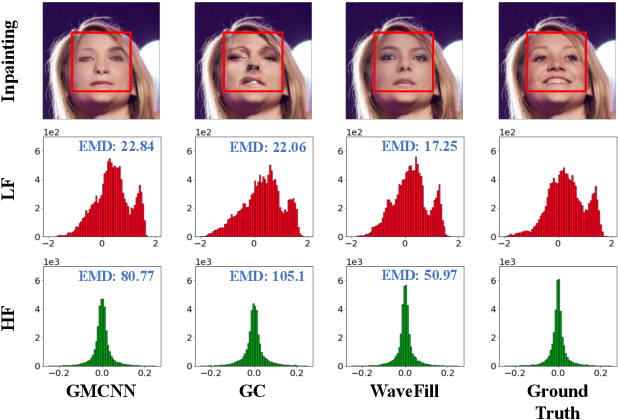

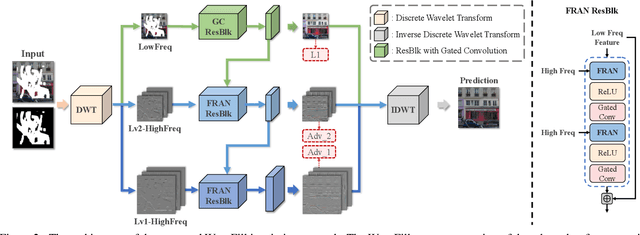
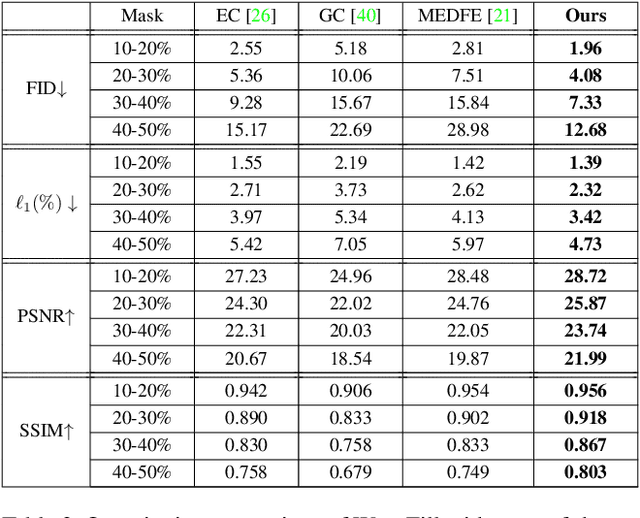
Abstract:Image inpainting aims to complete the missing or corrupted regions of images with realistic contents. The prevalent approaches adopt a hybrid objective of reconstruction and perceptual quality by using generative adversarial networks. However, the reconstruction loss and adversarial loss focus on synthesizing contents of different frequencies and simply applying them together often leads to inter-frequency conflicts and compromised inpainting. This paper presents WaveFill, a wavelet-based inpainting network that decomposes images into multiple frequency bands and fills the missing regions in each frequency band separately and explicitly. WaveFill decomposes images by using discrete wavelet transform (DWT) that preserves spatial information naturally. It applies L1 reconstruction loss to the decomposed low-frequency bands and adversarial loss to high-frequency bands, hence effectively mitigate inter-frequency conflicts while completing images in spatial domain. To address the inpainting inconsistency in different frequency bands and fuse features with distinct statistics, we design a novel normalization scheme that aligns and fuses the multi-frequency features effectively. Extensive experiments over multiple datasets show that WaveFill achieves superior image inpainting qualitatively and quantitatively.
Sparse Needlets for Lighting Estimation with Spherical Transport Loss
Jun 24, 2021



Abstract:Accurate lighting estimation is challenging yet critical to many computer vision and computer graphics tasks such as high-dynamic-range (HDR) relighting. Existing approaches model lighting in either frequency domain or spatial domain which is insufficient to represent the complex lighting conditions in scenes and tends to produce inaccurate estimation. This paper presents NeedleLight, a new lighting estimation model that represents illumination with needlets and allows lighting estimation in both frequency domain and spatial domain jointly. An optimal thresholding function is designed to achieve sparse needlets which trims redundant lighting parameters and demonstrates superior localization properties for illumination representation. In addition, a novel spherical transport loss is designed based on optimal transport theory which guides to regress lighting representation parameters with consideration of the spatial information. Furthermore, we propose a new metric that is concise yet effective by directly evaluating the estimated illumination maps rather than rendered images. Extensive experiments show that NeedleLight achieves superior lighting estimation consistently across multiple evaluation metrics as compared with state-of-the-art methods.
Unbalanced Feature Transport for Exemplar-based Image Translation
Jun 19, 2021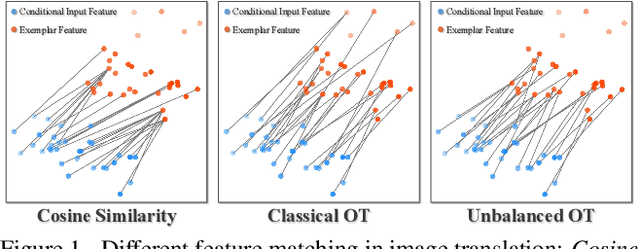

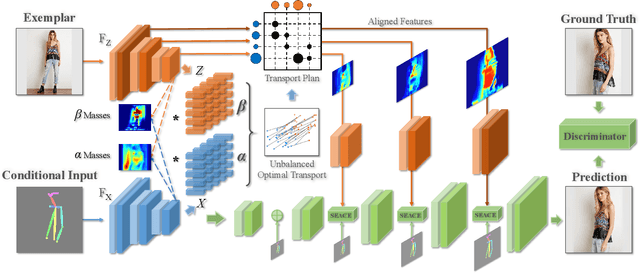
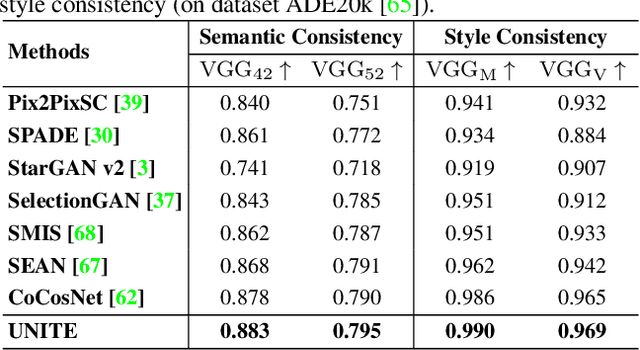
Abstract:Despite the great success of GANs in images translation with different conditioned inputs such as semantic segmentation and edge maps, generating high-fidelity realistic images with reference styles remains a grand challenge in conditional image-to-image translation. This paper presents a general image translation framework that incorporates optimal transport for feature alignment between conditional inputs and style exemplars in image translation. The introduction of optimal transport mitigates the constraint of many-to-one feature matching significantly while building up accurate semantic correspondences between conditional inputs and exemplars. We design a novel unbalanced optimal transport to address the transport between features with deviational distributions which exists widely between conditional inputs and exemplars. In addition, we design a semantic-activation normalization scheme that injects style features of exemplars into the image translation process successfully. Extensive experiments over multiple image translation tasks show that our method achieves superior image translation qualitatively and quantitatively as compared with the state-of-the-art.
Sign-Agnostic CONet: Learning Implicit Surface Reconstructions by Sign-Agnostic Optimization of Convolutional Occupancy Networks
May 08, 2021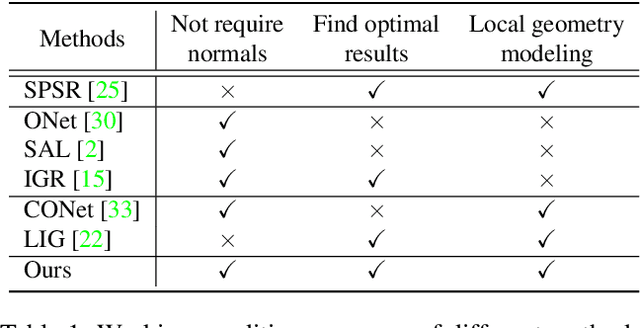
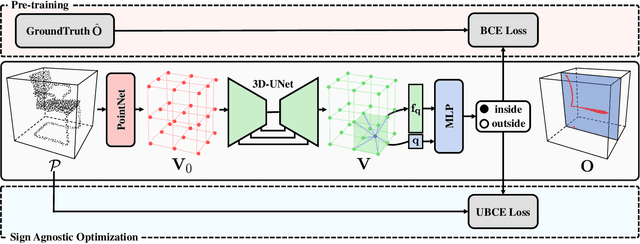
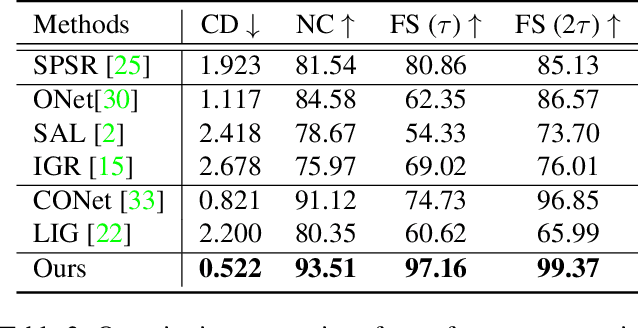
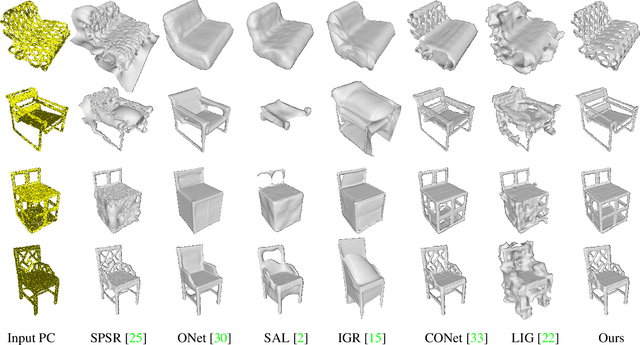
Abstract:Surface reconstruction from point clouds is a fundamental problem in the computer vision and graphics community. Recent state-of-the-arts solve this problem by individually optimizing each local implicit field during inference. Without considering the geometric relationships between local fields, they typically require accurate normals to avoid the sign conflict problem in overlapping regions of local fields, which severely limits their applicability to raw scans where surface normals could be unavailable. Although SAL breaks this limitation via sign-agnostic learning, it is still unexplored that how to extend this pipeline to local shape modeling. To this end, we propose to learn implicit surface reconstruction by sign-agnostic optimization of convolutional occupancy networks, to simultaneously achieve advanced scalability, generality, and applicability in a unified framework. In the paper, we also show this goal can be effectively achieved by a simple yet effective design, which optimizes the occupancy fields that are conditioned on convolutional features from an hourglass network architecture with an unsigned binary cross-entropy loss. Extensive experimental comparison with previous state-of-the-arts on both object-level and scene-level datasets demonstrate the superior accuracy of our approach for surface reconstruction from un-orientated point clouds.
Diverse Image Inpainting with Bidirectional and Autoregressive Transformers
Apr 30, 2021
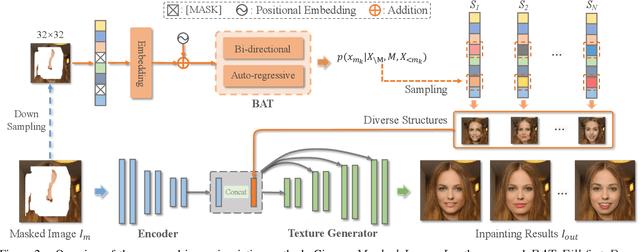
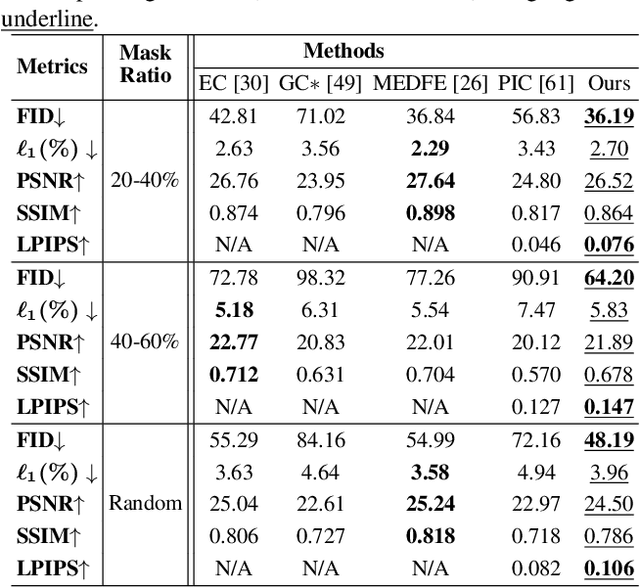
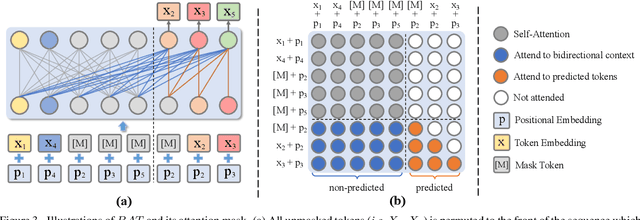
Abstract:Image inpainting is an underdetermined inverse problem, it naturally allows diverse contents that fill up the missing or corrupted regions reasonably and realistically. Prevalent approaches using convolutional neural networks (CNNs) can synthesize visually pleasant contents, but CNNs suffer from limited perception fields for capturing global features. With image-level attention, transformers enable to model long-range dependencies and generate diverse contents with autoregressive modeling of pixel-sequence distributions. However, the unidirectional attention in transformers is suboptimal as corrupted regions can have arbitrary shapes with contexts from arbitrary directions. We propose BAT-Fill, an image inpainting framework with a novel bidirectional autoregressive transformer (BAT) that models deep bidirectional contexts for autoregressive generation of diverse inpainting contents. BAT-Fill inherits the merits of transformers and CNNs in a two-stage manner, which allows to generate high-resolution contents without being constrained by the quadratic complexity of attention in transformers. Specifically, it first generates pluralistic image structures of low resolution by adapting transformers and then synthesizes realistic texture details of high resolutions with a CNN-based up-sampling network. Extensive experiments over multiple datasets show that BAT-Fill achieves superior diversity and fidelity in image inpainting qualitatively and quantitatively.
GMLight: Lighting Estimation via Geometric Distribution Approximation
Feb 20, 2021



Abstract:Lighting estimation from a single image is an essential yet challenging task in computer vision and computer graphics. Existing works estimate lighting by regressing representative illumination parameters or generating illumination maps directly. However, these methods often suffer from poor accuracy and generalization. This paper presents Geometric Mover's Light (GMLight), a lighting estimation framework that employs a regression network and a generative projector for effective illumination estimation. We parameterize illumination scenes in terms of the geometric light distribution, light intensity, ambient term, and auxiliary depth, and estimate them as a pure regression task. Inspired by the earth mover's distance, we design a novel geometric mover's loss to guide the accurate regression of light distribution parameters. With the estimated lighting parameters, the generative projector synthesizes panoramic illumination maps with realistic appearance and frequency. Extensive experiments show that GMLight achieves accurate illumination estimation and superior fidelity in relighting for 3D object insertion.
EMLight: Lighting Estimation via Spherical Distribution Approximation
Dec 21, 2020



Abstract:Illumination estimation from a single image is critical in 3D rendering and it has been investigated extensively in the computer vision and computer graphic research community. On the other hand, existing works estimate illumination by either regressing light parameters or generating illumination maps that are often hard to optimize or tend to produce inaccurate predictions. We propose Earth Mover Light (EMLight), an illumination estimation framework that leverages a regression network and a neural projector for accurate illumination estimation. We decompose the illumination map into spherical light distribution, light intensity and the ambient term, and define the illumination estimation as a parameter regression task for the three illumination components. Motivated by the Earth Mover distance, we design a novel spherical mover's loss that guides to regress light distribution parameters accurately by taking advantage of the subtleties of spherical distribution. Under the guidance of the predicted spherical distribution, light intensity and ambient term, the neural projector synthesizes panoramic illumination maps with realistic light frequency. Extensive experiments show that EMLight achieves accurate illumination estimation and the generated relighting in 3D object embedding exhibits superior plausibility and fidelity as compared with state-of-the-art methods.
Adversarial Image Composition with Auxiliary Illumination
Sep 17, 2020



Abstract:Dealing with the inconsistency between a foreground object and a background image is a challenging task in high-fidelity image composition. State-of-the-art methods strive to harmonize the composed image by adapting the style of foreground objects to be compatible with the background image, whereas the potential shadow of foreground objects within the composed image which is critical to the composition realism is largely neglected. In this paper, we propose an Adversarial Image Composition Net (AIC-Net) that achieves realistic image composition by considering potential shadows that the foreground object projects in the composed image. A novel branched generation mechanism is proposed, which disentangles the generation of shadows and the transfer of foreground styles for optimal accomplishment of the two tasks simultaneously. A differentiable spatial transformation module is designed which bridges the local harmonization and the global harmonization to achieve their joint optimization effectively. Extensive experiments on pedestrian and car composition tasks show that the proposed AIC-Net achieves superior composition performance qualitatively and quantitatively.
Towards Realistic 3D Embedding via View Alignment
Jul 14, 2020



Abstract:Recent advances in generative adversarial networks (GANs) have achieved great success in automated image composition that generates new images by embedding interested foreground objects into background images automatically. On the other hand, most existing works deal with foreground objects in two-dimensional (2D) images though foreground objects in three-dimensional (3D) models are more flexible with 360-degree view freedom. This paper presents an innovative View Alignment GAN (VA-GAN) that composes new images by embedding 3D models into 2D background images realistically and automatically. VA-GAN consists of a texture generator and a differential discriminator that are inter-connected and end-to-end trainable. The differential discriminator guides to learn geometric transformation from background images so that the composed 3D models can be aligned with the background images with realistic poses and views. The texture generator adopts a novel view encoding mechanism for generating accurate object textures for the 3D models under the estimated views. Extensive experiments over two synthesis tasks (car synthesis with KITTI and pedestrian synthesis with Cityscapes) show that VA-GAN achieves high-fidelity composition qualitatively and quantitatively as compared with state-of-the-art generation methods.
 Add to Chrome
Add to Chrome Add to Firefox
Add to Firefox Add to Edge
Add to Edge